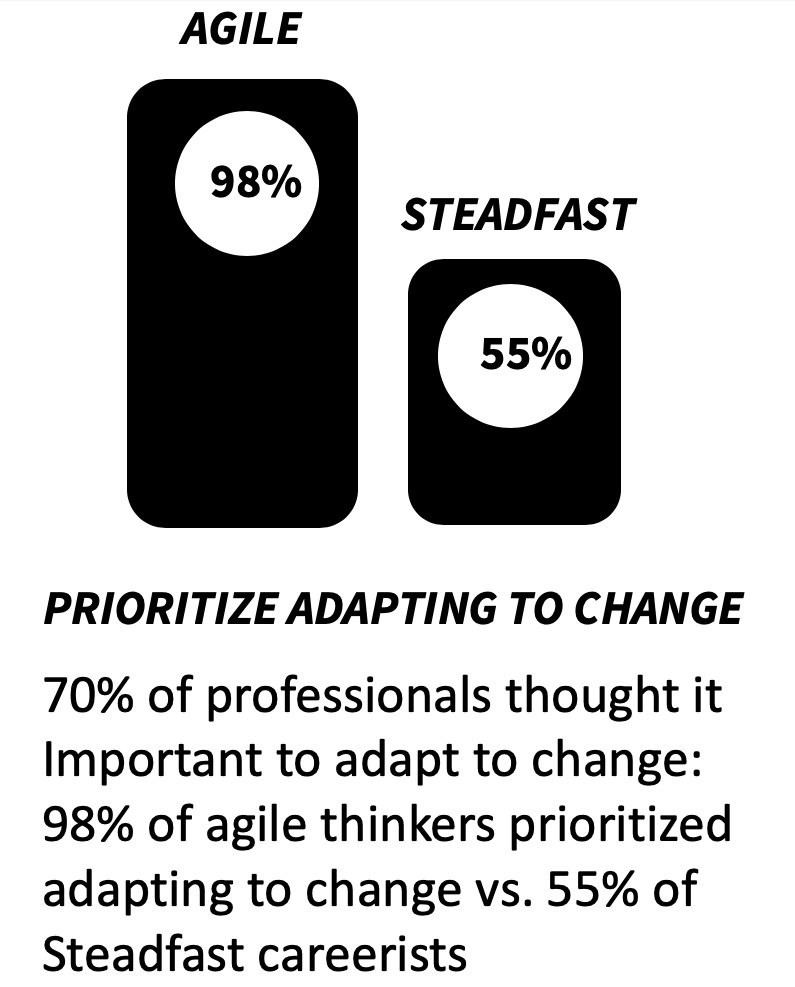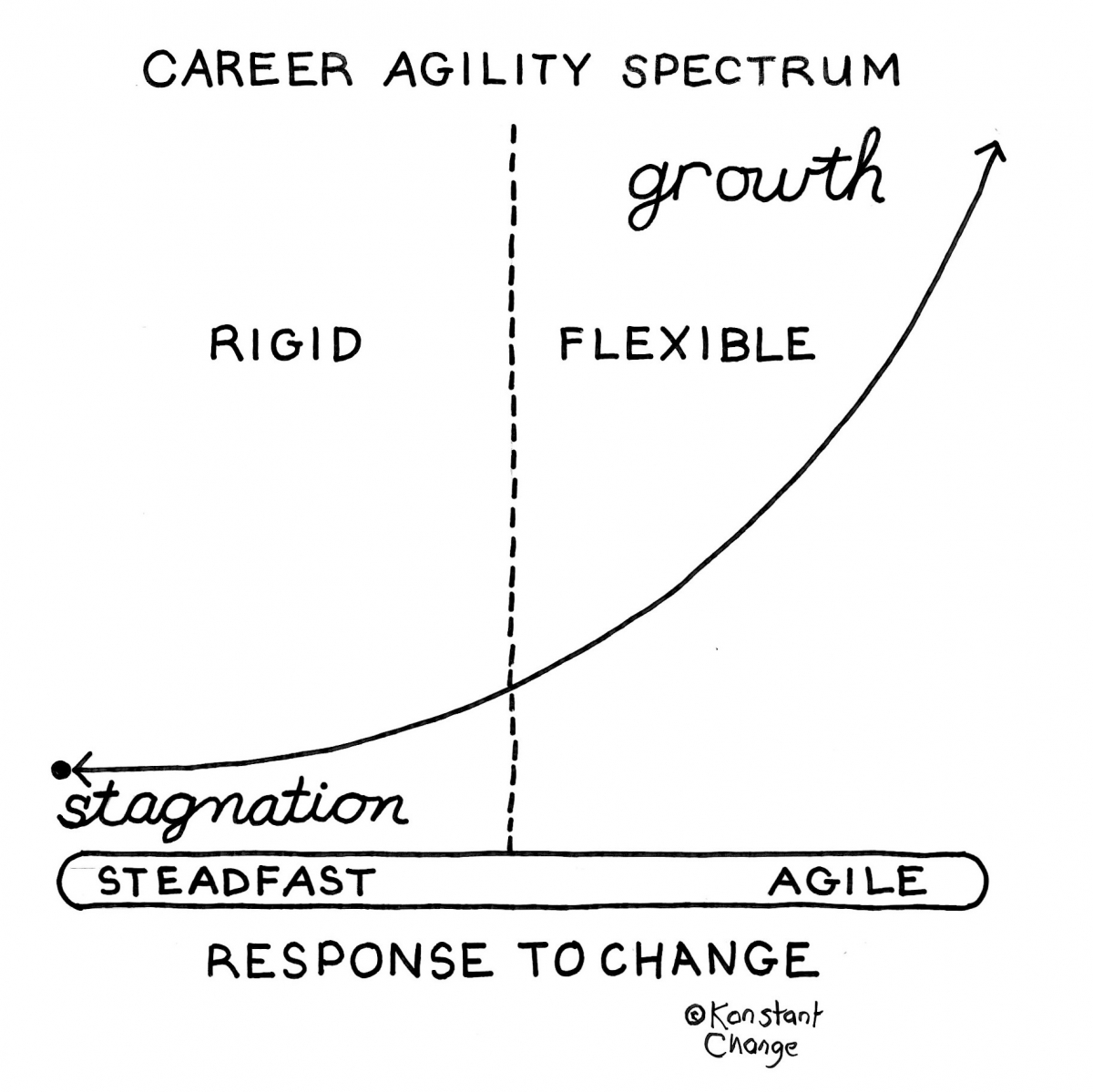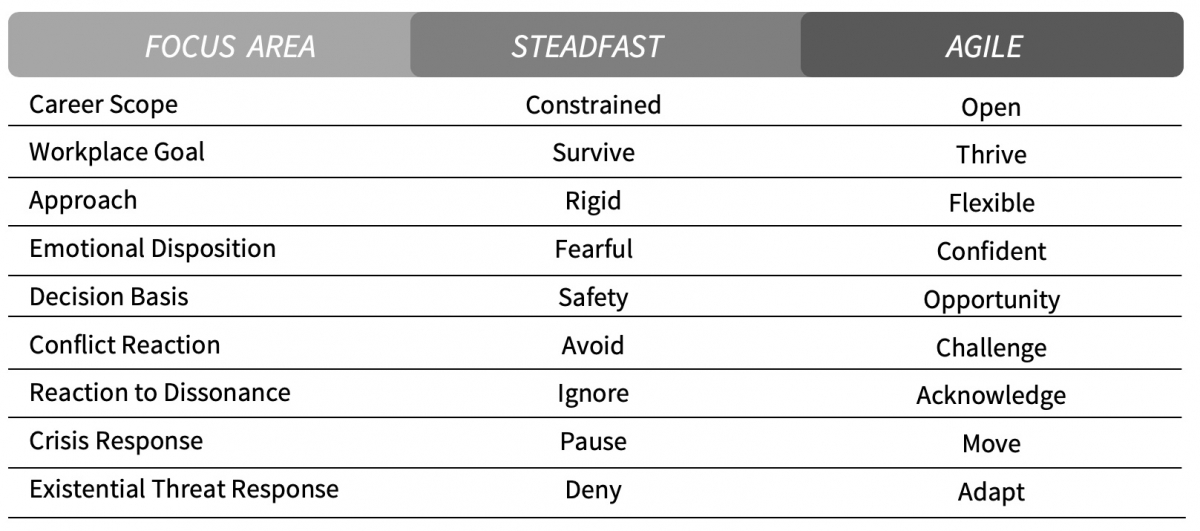The modern economy is shifting away from traditional steady employment patterns and accompanying worker mindsets, toward increasingly dynamic and often ephemeral lifecycles.
Company longevity is in decline and the employer-employee relationship is evolving to meet the needs of the future workplace. In response, successful individuals are recalibrating their approaches to and expectations from the world of work, building individual brands and untethered career trajectories. Such individual agility need not pose a threat to organizational success, and instead provides corporate leadership with new opportunities for productivity, innovation, and retention.
My white paper, “Happy Profitable Employees: Cultivate Career Agility, Don’t Fight It,” examines the need for workplace agility and lays out practical advice for leaders and hiring managers to cultivate and leverage career agility instead of combating it.
The world of work is not evolving. Rather, today’s workplace exists in a state of creative destruction and constant reinvention. This ongoing transformation demands a new outlook for employers and workers alike. Corporate leadership, middle management, indeed, all types of contributors must learn to adapt to this inexorable current of change or find themselves unemployed and unemployable. At the macro level, companies and ecosystems that fail to acknowledge this constant flux will fail and fade away or already have done so.
The shrinking corporate lifecycle is not exactly headline news. Over the last decade, business visionaries and social commentators have predicted the demise of the legacy corporate landscape. They foretell the extinction of a large swath of well-established companies occurring in fewer than 10 years—and this may happen even sooner in the wake of the COVID-19 pandemic.
The list of companies that have already succumbed to destructive change is long and sobering, full of brands that once defined the modern economy. Even startups—the “new kids on the block,” companies that disrupt the existing marketplace—are not themselves immune to disruption, especially if they slip into the roles and habits of the players they displace. The lifespans of new companies, no matter how nimble they appear, are similarly predicted to shorten, to be even briefer than their predecessors.
To meet this wave of disruptive—even destructive—change, organizations will require agility in their workforce, leadership, and practices. Organizations, leadership, and staff need to adapt to the pace of change. Exponential scaling must replace linear models to achieve and sustain growth and marketplace relevance—all else results in functional stagnation.
The Career Agility Research Project
The genesis of my white paper is the Career Agility Research Project, a multi-year effort combining more than 100 interviews with substantial survey data gathered and analyzed by Researchscape International. The project studied how Millennials, Gen Xers, and Baby boomers navigate their careers in this era of change and uncertainty.
The Agile Mindset
An agile mindset is foundational in both individuals and organizations who foster growth. Findings from the Career Agility Research Project revealed a spectrum spanning two career mindset types, from Steadfast to Agile. The agility range also correlated with overall rigidity vs. flexibility and a progress measurement of stagnation vs. growth. All professionals fall somewhere along this spectrum.



Career Agility Attributes + Sustaining an Agility Initiative
The contrasts help define the agile mindset, and in our study yielded a series of attributes and habits with direct impact on career success. Consistently, agile careerists exhibit a combination of the following seven attributes:
1. Ability to respond to change
2. Career path introspection (e.g., “A/B testing” career choices)
3. Parallel pursuits, in and out of the workplace
4. Habitually capturing transitory ideas (a.k.a., “Idea Zone” or “Parking Lot”)
5. Viewing one’s career as a series of projects
6. Seeking feedback from peers and managers (continuously and at key junctures)
7. Cultivating a personal brand
Here are topline steps to roll out and sustain an agility initiative:
1. Cultivate an agile mindset: Understanding agility represents only a first step to realizing and cultivating it in the workplace among team members. Agility doesn’t “just happen”—it requires changes in policy, management practices, and leadership vision.
2. Cultivate Leadership Agility: >You might imagine that corporate leadership, by definition, embodies an agile mindset. But many managers rise through the ranks more on steadfast thinking than inspired agility. Non-agile mindsets translate into day-to-day management outlooks. Middle managers, especially, often possess role-based, steadfast expectations for their reports.
3. Sustain Career Evolution; Prevent Stagnation: There is nothing more disheartening and damaging to retention than the perception of a “dead-end” job. The need for career evolution applies across the entire workforce. To avoid career stasis and stagnation, an agility-enabling organization needs to embrace the notion of career trajectory and commit to remediating tradition shortcomings.
4. Nurture a Culture of Learning: Think back to your first job out of college. Did your degree truly prepare you to face your first year on the job? The next 10 years? Learning on the job, through direct experience and through mentoring is how we all shape our careers. But imagine how much further and faster careers could evolve when augmented by training, directed for both specialization and for workplace skills development (a.k.a., agility).
5. Promote Mentorship and Coaching: Mentoring, while natural to some workers and leaders, does not happen spontaneously. Certainly, employees and managers will look to one another for help and advice informally, but many team members can be reluctant to set aside time not strictly accounted for in project schedules and terms of employment.
6. Support Workplace Experimentation: The Nike trademark phrase, “Just Do It,” can cut two ways in the workplace. The traditional management imperative of “Do as I say and do it now” is clearly no facilitator of agility. By contrast, giving team members freedom and flexibility in how they implement tasks and execute projects fosters both individual and organizational agility.
7. Facilitate Personal Brand Growth: Commoditization of team members is one of the greatest risks in a pre-agile workplace. Companies spend millions annually on corporate and product branding but never give a thought to the personal brands of the workers that enable market success. For their part, only the most agile-minded employees pause to consider their personal brands.
Excerpt from white paper “Happy Profitable Employees: Cultivate Career Agility, Don’t Fight It” by Marti Konstant. For more information, visit: http://martikonstant.com/hpe-whitepaper.pdf
Marti Konstant is a workplace futurist and the best-selling author of “Activate Your Agile Career.” She has an MBA from the University of Chicago Booth School of Business and is a former technology executive from Silicon Valley. She has been featured in media outlets such as NBC Chicago, Levo League, and The Muse, and was named a top career influencer to watch. Konstant has worked with companies such as Samsung, Dow Jones, and Apple. She is an investor in multiple technology companies and an expert in applying agile principles to workforce development.




